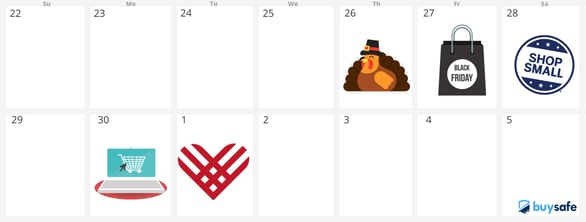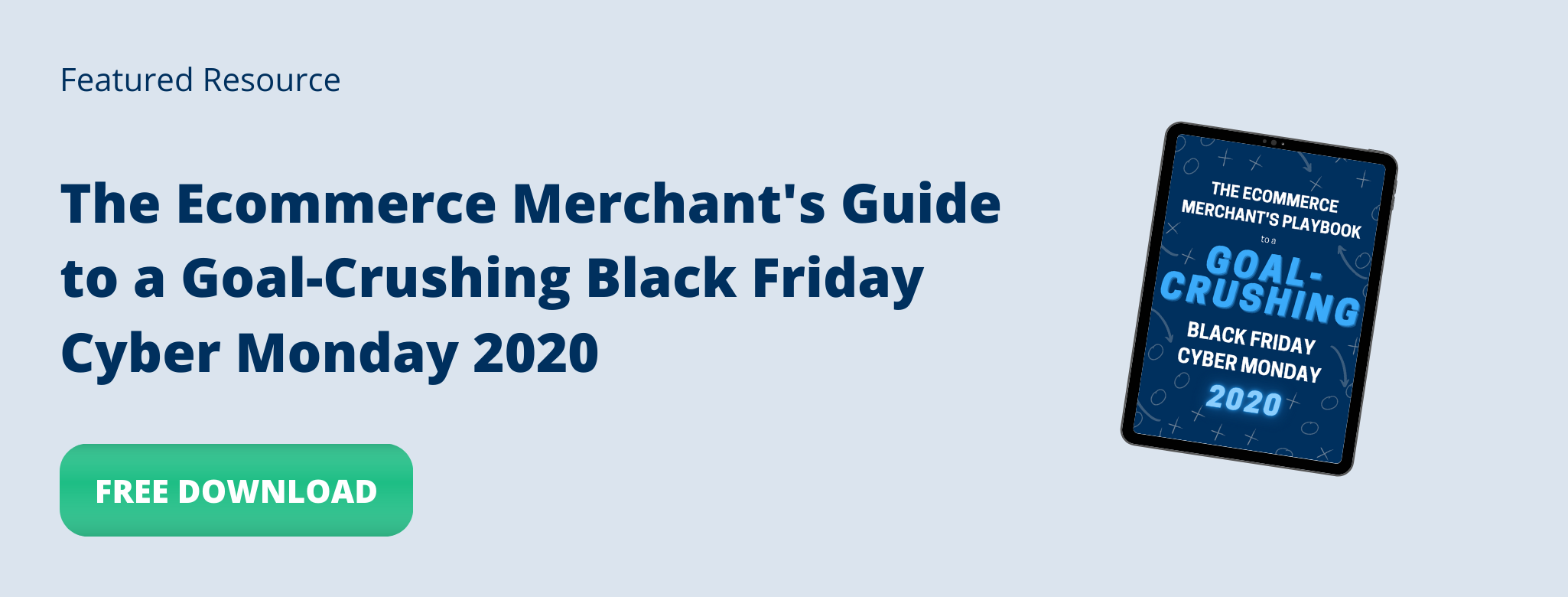

For the latest on ecommerce tips and best practices.
How to Make a Plan for the Biggest Black Friday Cyber Monday [2020 Strategies]

The largest holiday shopping season is fast approaching. With the ongoing coronavirus pandemic, shoppers are less likely to storm the stores in-person, and opt for a safer online shopping weekend. With over $9.4 billion spent by shoppers on Cyber Monday in 2019, your ecommerce store must prepare in order to take a piece of that consumer-shopping-pie.
Key dates
Mark these key dates on your calendar:
- Thanksgiving 2020 is on Thursday, November 26
- Black Friday 2020 is on Friday, November 27
- Small Business Saturday 2020 is on Saturday, November 28
- Cyber Monday 2020 is on Monday, November 30
- Giving Tuesday 2020 is on Tuesday, December 1
Review
In order to crush your goals this Black Friday Cyber Monday you need to set the goals. Start by analyzing your past year’s performance. Then, add a percentage of growth that you expect this year. We’ll use this number to back-into your overall Black Friday Cyber Monday goals which will drive your campaigns, reach and ad spend.Let’s take a look back into your 2019 BFCM to help us plan for this year. The key metrics we are looking for are:
- Average order value
- 2019 BFCM Revenue
These numbers will help us set a realistic revenue goal for 2020 as well as predict conversions in dollars depending on the marketing channels we choose to use.
Set Goals
If you have your own forecasting methods, use your target seasonal numbers for the Black Friday Cyber Monday weekend. If you’re not sure what your year over year growth should be, or you lack the historic data, check out Shopify’s post on how to forecast for seasonal business or use the average year over year growth reported by BigCommerce. From 2018 to 2019 Cyber Monday doubled in Year over Year (YoY) gross merchandise value (GMV) increase from 6.3% to 13% and Black Friday YoY GMV increased from 16% to 23%.
Averaging the BF and CM growth rates gives us a target growth rate of 6.85%. Here’s the formula…
2019 BFCM Revenue x Target Growth = 2020 BFCM Revenue Goal
Say we have an outdoor store that made $30,000 over the four days of Black Friday Cyber Monday. We are going to use a target growth of 6.85%.
$30,000 x 6.85% = $32,055
How are we going to reach this goal? Let’s break down our customer acquisition channels and their estimated traffic and conversion rates. This will help hone in on our budgeted ad spend to reach our goal.
Evaluate your Customer Acquisition Channels
Your ad spend will vary depending on your ad type, audience targeting and keywords. For this exercise we’re using average conversion rates from WebFX, WordStream and Shopify. The best indicator for your business will be logging in to your individual ad accounts and seeing your impressions and conversion rates based upon previous ad campaigns.
| Channel | Impressions | Avg. Conversion Rate | Avg. Order Value | Ad Cost | COGS | Gross Margin |
| Direct | 2,450 | 2.63% | $35 | $0 | $1,014.85 | $1,240.37 |
| Organic Search | 1,050 | 2.63% | $35 | $0 | $434.94 | $531.59 |
| 10,000 | 4.00% | $35 | $0 | $6,300 | $7,700.00 | |
| 27,800 | 1.85% | $35 | $200 | $8,100.23 | $9,700.28 | |
| 25,200 | 1.08% | $35 | $200 | $4,286.52 | $5,039.08 | |
| YouTube | 20,600 | 1.16% | $35 | $200 | $3,763.62 | $4,399.98 |
| 30,900 | 0.77% | $35 | $200 | $3,747.40 | $4,380.15 | |
| TOTAL | $32,991.45 |
Play with your ad budgets and channels in order to achieve the estimated total revenue you are targeting for BFCM. Maybe you have found success with influencer marketing, so your Instagram ad budget may double and go towards influencer partnerships. If Facebook hasn't been performing, try a new channel, like Reddit.
Download the Ecommerce Merchant's Guide to a Goal-Crushing Black Friday Cyber Monday
Outline your Deals
Determine what deals you want to offer over BFCM that make sense for your bottom-line. Some ideas:
- Free shipping: using your average order value and cost of goods sold, determine the price point that you can start offering free shipping. Make sure you are never losing money on orders shipped out.
- Deal Wheel: entice users when they get to your site or are about to leave with a spin the wheel deal.
- Time-Specific Deals: limiting time on deals offered instills urgency in shoppers, making them more likely to buy. Also, it keeps them coming back to check for new deals going live in the future. Try out Bold Discounts to stay organized.
- Sitewide deals: blanketed deals so customers can choose what they like and still get a discount.
Retailers are offering their discounts earlier and extending them past the shopping weekend. Don’t be hesitant to offer your deals for longer periods of time. Retailers like Amazon create their own deal days. Prime Day is on October 13 and 14 this year spurring other retailers to also promote their own deal days, like Target Deal Days on the same days and Walmart’s Big Save Event running from October 11-15. Consider running some specials and ads promoting your small business and deterring shoppers from buying from big box stores on these deal days.
Check up on Logistics
Using your previous year’s sales and known trends of this year, make sure your inventory can support the deals you want to offer. Check in with your suppliers on popular items you’ll be running deals on.
Be sure to ask your shipping services if they expect delays due to the pandemic and clearly communicate this pre and post-purchase with your shoppers. If you anticipate longer shipping times, think about offering your deals a week or two before the Black Friday Cyber Monday weekend to ensure delivery before the holidays.
Stay in the know
Subscribe to the buySAFE blog and receive the latest in ecommerce best practices.




